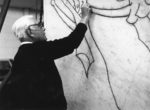
Rufino Tamayo
Mexican, 1899-1991 (active USA and France)
Personage in a Cave, 1967
color lithograph
39 x 29 in.
SBMA, Gift of Miss Alice Erving to the Ala Story Collection
1971.9

Rufino Tamayo working on creating the lithographic stone for “Dos Personajes Atacados Por Perros,” 1983. | Photo: Courtesy of Mixografia.
COMMENTS
Rufino Tamayo was a Mexican painter and printmaker known for his large-scale murals and vivid use of color. Like Diego Rivera, David Alfaro Siqueiros, and José Clemente Orozco, Tamayo attracted international attention for Mexican art. Influenced by Modern movements such as Cubism, Surrealism, and Expressionism, Tamayo wove his country’s native motifs into his painting with a signature figurative style. Born on August 26, 1899 in Oaxaca, Mexico, Tamayo left the Academy of San Carlos in Mexico City after a year and began to teach himself. He moved to New York in the 1930s after a falling out with the politically activist artists he knew at home. Tamayo’s work has been exhibited worldwide in museums including the Solomon R. Guggenheim Museum in New York, the Naples Museum of Art in Naples, The Museo Nacional Centro de Arte Reina Sofia in Madrid, and the Phillips Collection in Washington, D.C. The artist would eventually return to his home country in 1959, where he died on June 24, 1991 in Mexico City, Mexico at the age of 91. In 1981, he founded the Museo Tamayo Arte Contemporáneo, which houses his Modern Art collection, and the Museo Rufino Tamayo in his birthplace of Oaxaca for his extensive pre-Columbian collection.
artnet.com
